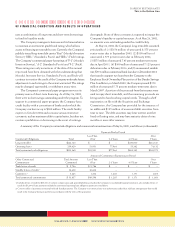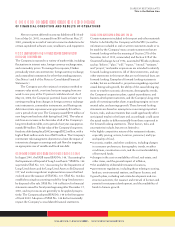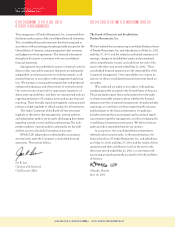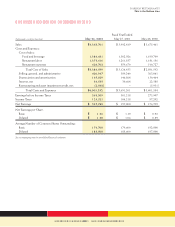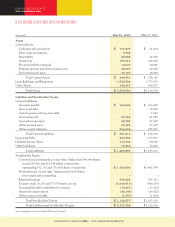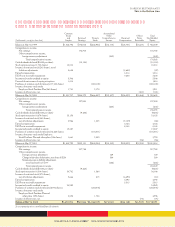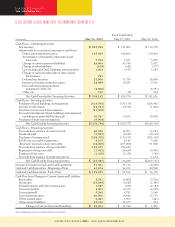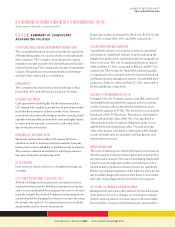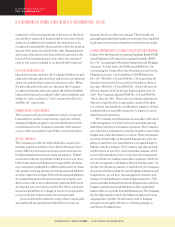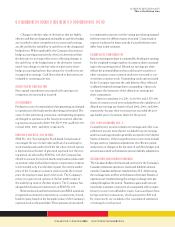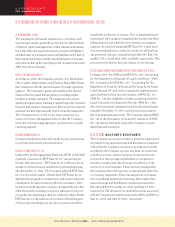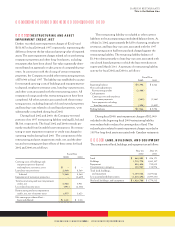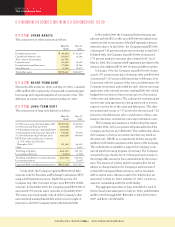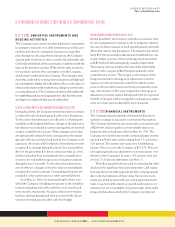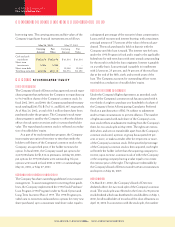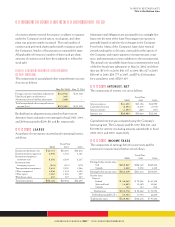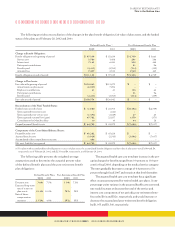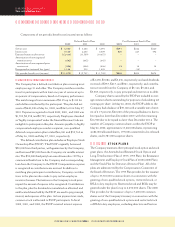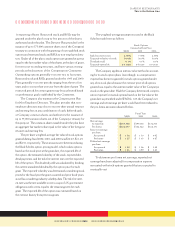Red Lobster 2002 Annual Report Download - page 34
Download and view the complete annual report
Please find page 34 of the 2002 Red Lobster annual report below. You can navigate through the pages in the report by either clicking on the pages listed below, or by using the keyword search tool below to find specific information within the annual report.
Notes to Consolidated Financial Statements
DARDEN RESTAURANTS
This is the Bottom Line
Changes in the fair value of derivatives that are highly
effective and that are designated and qualify as cash flow hedges
are recorded in other comprehensive income until earnings
are affected by the variability in cash flows of the designated
hedged item. Where applicable, the Company discontinues
hedge accounting prospectively when it is determined that
the derivative is no longer effective in offsetting changes in
the cash flows of the hedged item or the derivative is termi-
nated. Any changes in the fair value of a derivative where
hedge accounting has been discontinued or is ineffective are
recognized in earnings. Cash flows related to derivatives are
included in operating activities.
Pre-Opening Expenses
Non-capital expenditures associated with opening new
restaurants are expensed as incurred.
Advertising
Production costs of commercials and programming are charged
to operations in the fiscal year the advertising is first aired. The
costs of other advertising, promotion, and marketing programs
are charged to operations in the fiscal year incurred. Advertis-
ing expense amounted to $187,950, $177,998, and $165,590,
in fiscal 2002, 2001, and 2000, respectively.
Stock-Based Compensation
SFAS No. 123, “Accounting for Stock-Based Compensation,”
encourages the use of a fair-value method of accounting for
stock-based awards under which the fair value of stock options
is determined on the date of grant and expensed over the vest-
ing period. As allowed by SFAS No.123, the Company has
elected to account for its stock-based compensation plans under
an intrinsic value method that requires compensation expense
to be recorded only, if on the date of grant, the current market
price of the Company’s common stock exceeds the exercise
price the employee must pay for the stock. The Company’s
policy is to grant stock options at the fair market value of
the underlying stock at the date of grant. The Company has
adopted the disclosure requirements of SFAS No.123.
Restricted stock and restricted stock unit (RSU) awards are
recognized as unearned compensation, a component of stock-
holders’ equity, based on the fair market value of the Company’s
common stock on the award date. These amounts are amortized
to compensation expense over the vesting period using assumed
forfeiture rates for different types of awards. Compensation
expense is adjusted in future periods if actual forfeiture rates
differ from initial estimates.
Net Earnings Per Share
Basic net earnings per share is computed by dividing net earnings
by the weighted-average number of common shares outstand-
ing for the reporting period. Diluted net earnings per share
reflects the potential dilution that could occur if securities or
other contracts to issue common stock were exercised or con-
verted into common stock. Outstanding stock options issued
by the Company represent the only dilutive effect reflected
in diluted weighted-average shares outstanding. Options do
not impact the numerator of the diluted net earnings per
share computation.
Options to purchase 161,220, 3,618,900, and 5,379,300
shares of common stock were excluded from the calculation of
diluted net earnings per share for fiscal 2002, 2001, and 2000,
respectively, because their exercise prices exceeded the aver-
age market price of common shares for the period.
Comprehensive Income
Comprehensive income includes net earnings and other com-
prehensive income items that are excluded from net earnings
under accounting principles generally accepted in the United
States of America. Other comprehensive income items include
foreign currency translation adjustments, the effective unreal-
ized portion of changes in the fair value of cash flow hedges, and
amounts associated with minimum pension liability adjustments.
Foreign Currency Translation
The Canadian dollar is the functional currency for the Company’s
Canadian restaurant operations. Assets and liabilities denomi-
nated in Canadian dollars are translated into U.S. dollars using
the exchange rates in effect at the balance sheet date. Results of
operations are translated using the average exchange rates pre-
vailing throughout the period. Translation gains and losses are
reported as a separate component of accumulated other compre-
hensive income in stockholders’ equity. Gains and losses from
foreign currency transactions, which amounted to $33 and
$1, respectively, are included in the consolidated statements
of earnings for each period.
Great Food and Beverage 31 Produce Great Results in 2002


